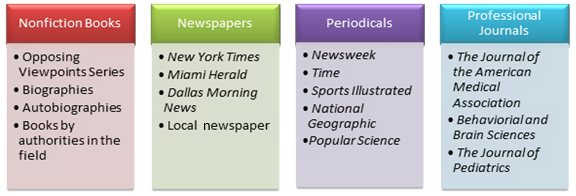
Source: “Mitchell Library, Sydney,” Christopher Chan, flickr
Now that you have an electronic or Internet source, you'll look at two print sources. Here are some examples of sources you might find in the library, but remember many print sources are also uploaded onto websites.

 An excerpt from a Psychology Today article written by Susan A. Smith appears below. Read through the excerpt and answer the questions that follow in your notes. When you are finished writing, check your understanding to see some possible responses.
An excerpt from a Psychology Today article written by Susan A. Smith appears below. Read through the excerpt and answer the questions that follow in your notes. When you are finished writing, check your understanding to see some possible responses. TV Makes You Smarter
How watching certain shows like Saturday Night Live can help improve your memory
Forget tutors—look to Darrell Hammond, Tina Fey and the rest of the Saturday Night Live gang to help you with your homework.
Researchers at Wisconsin's Marquette University found that watching comedy clips actually improves memory. Clinical psychologists Mark Powless and Kristy Nielson study “memory modulation,” the process by which we convert information from short-term to long-term memory. Previous studies have shown that memory can be boosted by disturbing stimuli like videos of surgery. Powless and Nielsen wondered whether positive emotions could also improve recall.
- What institution is mentioned that lends credibility to the article?
- What experts are mentioned, and what is the technical term they mention?
- How could you use this article in your persuasive essay to show that watching TV makes us smarter?
- Wisconsin's Marquette University
- Clinical psychologist Mark Powless and Kristy Nielson study “memory modulation,” which is the process of converting information from short-term to long-term memory.
- The most valuable information is that “watching comedy clips actually improves memory.” From here, you can use the example that the source provides, about how the two groups get different outcomes based on viewing a clip from SNL.
 The next article is from the Journal of the American Medical Association. Read the abstract, which is a summary of everything the article contains, and answer the questions that follow in your notes. Check your understanding when you are finished to see possible responses.
The next article is from the Journal of the American Medical Association. Read the abstract, which is a summary of everything the article contains, and answer the questions that follow in your notes. Check your understanding when you are finished to see possible responses. Television Viewing and Risk of Type 2 Diabetes, Cardiovascular Disease, and All-Cause Mortality
January 2011
A. Meta-analysis
- Anders Grontved, MPH, MSc
- Frank B. Hu, MD, PhD
Author Affiliations
1. Author Affiliations: Institute of Sport Science and Clinical Biomechanics, Department of Exercise Epidemiology, Center of Research in Childhood Health, University of Southern Denmark, Odense (Mr. Grontved); and Departments of Nutrition (Mr. Grontved and Dr. Hu) and Epidemiology (Dr. Hu), Harvard School of Public Health, Channing Laboratory, Harvard Medical School and Brigham and Women's Hospital (Dr. Hu), Boston, Massachusetts.
Abstract
Context. Prolonged television (TV) viewing is the most prevalent and pervasive sedentary behavior in industrialized countries and has been associated with morbidity and mortality. However, a systematic and quantitative assessment of published studies is not available.
Data Synthesis. The pooled relative risks per 2 hours of TV viewing per day were 1.20 (95% CI, 1.14-1.27) for type 2 diabetes, 1.15 (95% CI, 1.06-1.23) for fatal or nonfatal cardiovascular disease, and 1.13 (95% CI, 1.07-1.18) for all-cause mortality. While the associations between time spent viewing TV and risk of type 2 diabetes and cardiovascular disease were linear, the risk of all-cause mortality appeared to increase with TV viewing duration of greater than 3 hours per day. The estimated absolute risk differences per every 2 hours of TV viewing per day were 176 cases of type 2 diabetes per 100 000 individuals per year, 38 cases of fatal cardiovascular disease per 100 000 individuals per year, and 104 deaths for all-cause mortality per 100 000 individuals per year.
Conclusion. Prolonged TV viewing was associated with increased risk of type 2 diabetes, cardiovascular disease, and all-cause mortality.
- How many authors wrote the article? Are they credible and how do you know?
- When was the article published?
- What's the conclusion of the article?
- How is “prolonged” TV viewing defined?
- Would you use this in your essay about TV watching making us smarter?
- There are two writers for this article. The first writer has a master's degree in public health. The second writer is a physician and has a Ph.D.
- The article was published in November 2011.
- The conclusion is that “prolonged” TV watching can lead to Type 2 diabetes, obesity, and other serious illnesses.
- “Prolonged” TV viewing is defined as three hours or longer a day.
- Well, it depends. You could use this to show that while you believe that TV watching can make us smarter, you also know that it's important to do other things aside from watching TV. However, you may need to find other sources that will support your argument more completely.

Source: “Idiot Box,” Profound Whatever, flickr
Looking for the best sources to support your persuasive essays can be time consuming and challenging, but the reward for your patience and critical reading is an essay that has the power to change people's minds. Remember this the next time you are in an argument with parents or teachers. The more valid and reliable your support, the better chance you have of convincing someone to agree with your position. It's always a good feeling when you win someone over, whether it means more privileges in your family or convincing someone that TV watching can make us smarter!